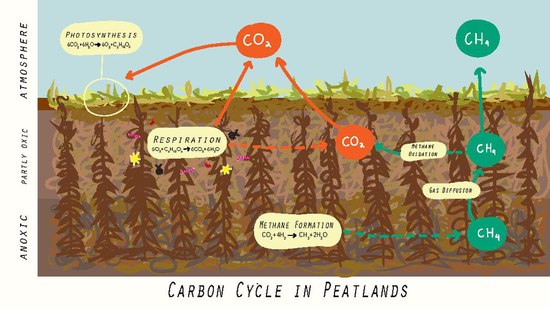The urgent restoration of all damaged peat reserves to a natural habitat and function which will result in the recovery of some of the benefits we gain from the peat resource. Increased monitoring of restoration schemes and the publication of new information. The Government to protect those peat reserves that are deemed to be. PEAT material does not necessarily reflect the views or policies of the Office of Disability Employment Policy, U.S. Department of Labor, nor does the mention of trade names, commercial products, or organizations imply endorsement by the U.S.
What is peat?
Peat is the surface organic layer of a soil that consists of partially decomposed organic matter, derived mostly from plant material, which has accumulated under conditions of waterlogging, oxygen deficiency, high acidity and nutrient deficiency.
In temperate, boreal and sub-arctic regions, where low temperatures (below freezing for long periods during the winter) reduce the rate of decomposition, peat is formed mainly from bryophytes (mostly sphagnum mosses), herbs, shrubs and small trees.
Peat Power Plant Pdf

Peat formation
The habitat requirements for peat initiation and accumulation are similar in every geographical location (waterlogging, low pH, low nutrient availability, low oxygen supply, reduced decomposition rate) but the physical and chemical characteristics differ according to specific site characteristics of landscape area and topography, climate, water depth and flow, nutrient availability and biogeographical availability of plant species.
Peat for horticulture
Peat is used in horticulture, as a soil improver and ingredient of growing media.
The volume used annually is about half that of fuel peat. Germany and Canada account for over half of horticultural peat extraction.
Other important peat production countries are the Baltic states, Finland, Ireland and Sweden but also Chile and Argentina.
Peat for heat and power
Peat has been an important local or regional energy source in Finland, Ireland and Sweden. (Joosten & Clarke, 2002, Wise Use of Mires and Peatlands).
Due to environmental pressures, increasing carbon trade prices and the climate targets the amount of peat for energy has declined drastically during the last few years.
Other uses
In addition to energy and horticulture, peat is used ex-situ as a raw material for chemistry (wax, dye, activated carbon, humic preparations, corrosion inhibition), as a bedding material for animals (horses, chicken, pigs), as a filter and absorbent material (oil spills, heavy metal removal, microbial carries)and also for peat textiles (cotton grass fibres, paper).
Organic soil
Some peatland authorities consider soils with surface organic layer less than 30% also to be peat but this is debateable. This approach gives rise to larger estimates of the global area of peatland although it does not increase the carbon store appreciably.
Organic soil is differentiated according to the degree of decomposition of organic matter. There are four Suborders of Histosol, namely, Fibrists, Hemists, Saprists and Folists. The first three represent increasing degree of decomposition and decreasing evidence of plant remains while the last is tree litter overlying rock or rubble.
Rate of peat accumulation and terrestrialisation
The rate at which organic matter accumulates to form ‘peat’ depends on the productivity of the aquatic vegetation that in turn is determined by the nutrient content of the water and, initially, the mineral substrate.
Shallow eutrophic lakes experience all stages of the hydrosere more quickly than deep eutrophic lakes or oligotrophic ones, whatever their depth.
Deep oligotrophic lakes may never infill because the productivity of plants growing in and around their margins is low owing to the lack of nutrients in the water, giving rise to a small annual plant biomass that is decomposed after each growing season.
Wise Use of Peatlands
Wise Use of peatlands can be described as the uses of peatlands for which reasonable people now and in the future will not attribute blame.
IPS has developed a framework for Wise Use to resolve conflicts between different values and uses of mires and peatlands. Overall, the major – anthropocentric – conflicts which arise with respect to peatland use are between those who wish to develop mires and peatlands for their production or carrier functions, and others who wish to preserve them for their regulation and non-material life-support functions.
Responsible peatland management means undertaking activities in a transparent and accountable manner, following ethical and humanitarian principles applied in ways that promote stewardship of the peatland resource that will be acceptable to future generations.
A responsible approach to managing peatland and peat considers its effect on people and ecosystem services, and balances environmental, social and economic functions.
Ramona The Pest Pdf Free
Certification for peat extraction
The intention of certification is to ensure that peatland will be used, managed and restored in a responsible way. Currently there are two schemes in use, RPP and Veriflora.
Who's A Pest Pdf
Peat suppliers
If you are looking for peat suppliers or peat producers, please contact the following companies or associations (most but not all of them are IPS members).
Play Pdf
Peat & Peatland Dictionary
The following PDF contains a complete list of almost 7000 peat and peatland related terms in English, German, Finnish, Swedish and Russian. For searching a certain term, click the link below and search the term using Ctrl F (Cmd F on Mac). You may also download the file on your device. Peat Dictionary – complete